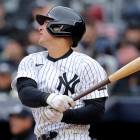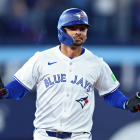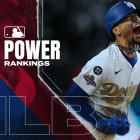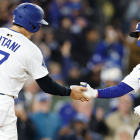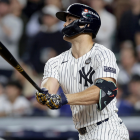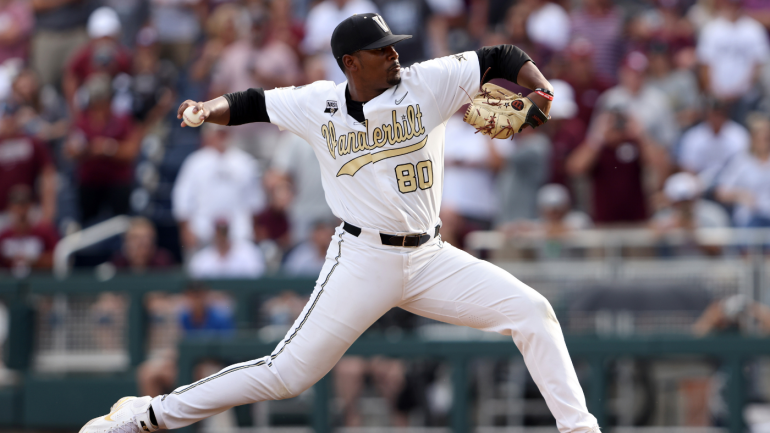
Major League Baseball's amateur draft is scheduled to begin on Sunday, July 11. As such, this presents as good of a time and as good of an opportunity as any to address the upcoming draft class. Below, you'll find the pre-draft top 50 -- that is, 50 players who we deemed worth including based on their combination of potential and expected draft slot. (The player ranked No. 5 might not go fifth overall, but they should go somewhere in the range.) These rankings are formed based primarily on conversations with scouts, analysts, and other front office types, as well as firsthand observations and historical data.
A lot has changed in five months' time, but if you'd like to compare the list below to the preseason edition, then click here. Remember, this is merely a snapshot of the present attitudes and evaluations on these players.
1. Marcelo Mayer, SS, Eastlake HS (CA)
Mayer makes the leap from No. 5 in the preseason to No. 1 now, but this spot could have gone to a couple other players without fuss. His boosters within the industry believe that he's the best player in the class: a potential 15-to-20-home-run-hitting shortstop who can deliver a good average and professional at-bats all the while. He isn't a fast runner, yet the smoothness of his defensive actions enable him to appear as though he's moving at a higher frames per second than the average prep shortstop. Depending on the extent of his projected power gains, he could finish his development with four plus tools (everything but the run), giving him a lofty ceiling that merits the top selection. Mayer is far more likely to become the first prep shortstop to go No. 1 since Royce Lewis in 2017 than he is to attend class in-person at USC this fall.
2. Jack Leiter, RHP, Vanderbilt
Leiter ranked No. 1 on the preseason list, and for good reason. He has a fastball that doesn't take the stairway to heaven so much as it ziplines in, hopping over bats on the way to the mitt. That effect is achieved by a combination of its innate "rise"; the flat plane his release point and stature create to the top of the zone; and its mid-to-upper-90s velocity. Scouts would like to see him become more consistent with his secondaries, but there is a belief that he'll be able to turn at least one of his breaking balls, be it his curveball or his slider, into a trusty outpitch before long. Leiter is held as intelligent and hardworking, and perhaps that shouldn't come as a surprise given that his father, uncle, and cousin all pitched in the majors. Add in how he dominated the SEC, arguably the best draftee-vetting tool at the disposal of MLB teams, and the only way he gets past Boston's fourth pick is if he wants to force himself elsewhere.
Jack Leiter's 13Ks in 6 ip. 🔥 pic.twitter.com/UfOU4NcK4v
— Rob Friedman (@PitchingNinja) May 16, 2021
3. Jordan Lawlar, SS, Dallas Jesuit HS (TX)
Lawlar draws comparisons to Royals prospect Bobby Witt Jr. because of a few biographical commonalities: both were born in Texas, and both were a little old for a prep prospect entering the draft. (Lawlar is 19.) The two share something else: an All-Star ceiling. Lawlar has a projectable frame and explosive hands that bode well for him developing plus power; on defense, he has a strong arm, above-average speed, and the other requisite traits to remain at the six. He has gone through stretches where he's swung and missed more frequently than scouts would like to see from a top prep player, and it's theoretically possible that his hit tool plays lighter than expected against high-grade pitching. He's been public about his desire to attend Vanderbilt, but that seems to be regarded as a negotiating tactic. Lawlar ought to go within the top three picks.
4. Henry Davis, C, Louisville
"Don't sleep on Davis as a dark horse to go in the top five," is how his preseason capsule began. Five months later, he's a legitimate candidate to go first overall, depending on his financial ask. Davis made the leap by hitting .370/.482/.663 this season with 15 home runs and seven more walks than strikeouts. The demand for two-way backstops always outpaces the supply, which is why Davis' upside is intriguing. He combines a low whiff rate with a high average exit velocity at the plate, and he's at least an adequate defender (with a strong arm) behind it. Some evaluators are concerned his strength-based swing won't work as well against advanced pitching. Fair enough, but he's the most accomplished collegiate bat in a class that doesn't have many of them, and it's hard to envision him slipping far beyond No. 5.
5. Kahlil Watson, SS, Wake Forest HS (NC)
In his spring capsule, CBS Sports noted: "Put a star next to Watson's name because there's a chance he becomes one." That assertion remains true. He has a beautiful modern swing, explosive actions, and a chance to develop into a well-rounded hitter who can remain at shortstop for the time being. There is a chance Watson outgrows short as he packs on muscle over the coming years; in that case, he could find a home in the outfield. Either way, he shouldn't be docked for being the third prep shortstop on this list: he's a tantalizing prospect with star upside. Watson's floor would seem to be the sixth pick, which ensures he won't be fulfilling his commitment to North Carolina State.
6. Jackson Jobe, RHP, Heritage Hall HS (OK)
There are scouts who believe Jobe is the best pitching prospect in the class. He's athletic and projectable, the way most prep arms are, but he's more polished than his peers. His fastball-slider combination produces some absurd metrics on the Trackman readout, to the degree that some evaluators believe he'll throw a pair of double-plus pitches at his peak. He's also gained ground with his changeup, a key factor when projecting younger arms. With all that established, high-school right-handers tend to go later than their talent and upside demand because of their extreme attrition risk. Jobe could prove to be the exception, with some rumors suggesting he could land as high as No. 3. Even if that doesn't come to fruition, he ought to go higher than Mick Abel did last June, when he was selected 15th by the Philadelphia Phillies.
7. Colton Cowser, OF, Sam Houston State
Cowser, who first impressed scouts by holding his own as one of the youngest members of Team USA, solidified himself as the second-best collegiate hitter in this class by batting .374/.490/.680 with 16 home runs, 17 steals (on 20 tries), and 10 more walks than strikeouts. Cowser's power surge is notable, since it was one of the big questions for him entering the year. (He'd previously launched just eight homers in his first 328 trips to the dish.) Factor in how there are evaluators who believe he'll begin his career in center thanks to his above-average speed and technique, and he's a surefire bet to eclipse Glenn Wilson (18th in 1980) as the highest selected Bearkat in school history.
8. Kumar Rocker, RHP, Vanderbilt
The most famous, and therefore the most scrutinized prospect in the class. Rocker is as physical as they come (he's listed at a Brad Keller- or Lance Lynn-like 6-foot-5, 245 pounds), and he possesses one of the draft's best chase pitches, in his trademark slider. Alas, there are several reasons he could drop outside of the top five, beginning with a velocity dip he experienced earlier this year. Rocker's changeup is underbaked, and scouts are concerned that his arsenal will play lighter than it should against big-league hitters. His mechanics, specifically a high elbow and an oft-late arm, are worrisome as it pertains to his command and durability. Rocker should still go in the top 10, and there's a chance he makes the skepticism look misplaced in due time.
9. Brady House, SS, Winder-Barrow HS (GA)
House is a polarizing prospect. His size (he's listed around 6-foot-3) and proneness to swinging and missing force evaluators to pick sides. Not everyone believes he's long for the shortstop opposition, or that his contact chops will enable him to maximize his near-elite raw power. A team that finds itself optimistic in both regards could pick him earlier than this, perhaps even at No. 3. If that doesn't happen, some club will be thrilled to land this kind of upside in the back half of the top 10. House has a commitment to Tennessee, but don't expect Rocky Top to be home sweet home to him come the fall.
10. Sam Bachman, RHP, Miami (OH)
Bachman has tremendous stuff. His turbo sinker can clear triple digits (though it's not a huge bat-misser within the zone) and his slider is a legit outpitch. Analysts like his seldom-used changeup, too, suggesting he should have three above-average offerings at his peak. He's not higher on the list because he has an unusual delivery (his arm goes up early and stays up) and a concerning injury history. Hypothetically, he would make sense as a quick-moving bullpen conversion piece, akin to what the White Sox did last year with Garrett Crochet. These things tend to get talked about more frequently than they happen.
Sam Bachman, 101mph Fastball (Miami Ohio). 🔥 https://t.co/xlvNK3U8gb
— Rob Friedman (@PitchingNinja) March 30, 2021
11. Matt McLain, SS, UCLA
McLain, who hit .333/.434/.579 with nine home runs and nine steals (on 10 tries) for the Bruins this season, is all but guaranteed to be the first collegiate middle infielder to come off the board. When that happens, it'll mark the second time he's been drafted in the first round, as he elected to not sign in 2018 after being selected 25th overall by the Arizona Diamondbacks. McLain is an above-average runner with enough arm to stick at short (though some evaluators believe he'll slide back to center field, the position he played for the Bruins as a freshman). Offensively, he has a below-average power projection, which in turn could suppress his average and on-base abilities. This is a weak class for collegiate hitters, so he's a layup to go within the 10-to-15 range.
12. Will Taylor, OF, Dutch Fork HS (SC)
This will probably prove to be a misrank of Taylor, who could go either within the top-10 selections, or who could slip well down the board if he overplays his hand or decides not to sign. (He has a commitment to play both baseball and football at Clemson.) Taylor is a twitchy athlete with a swing that's tailored for average as well as a strong arm and plus-plus speed. If he chooses baseball, it's easy to envision him outperforming his draft slot in due time.
13. Ty Madden, RHP, Texas
The Longhorns haven't produced a pitcher who started at least 50 big-league games since Roger Clemens in the '80s. Madden has a chance to snap that streak, but it's no sure thing. His fastball should give him another plus offering, yet it didn't miss bats the way a top prospect's four-seamer ought to at the college level. Some analysts are higher on a changeup that scouts perceive as not even fringe-average; the two sides can agree that his command has a tendency to waver. It stands to reason that Madden will need to make gains with his changeup and/or his command to avoid the bullpen. His ceiling is such that he's likely to go in the top 15 picks.
Ty Madden, Filthy Breaking Ball. 😷 pic.twitter.com/ZHTVxyTatR
— Rob Friedman (@PitchingNinja) June 26, 2021
14. Sal Frelick, OF, Boston College
Frelick was a highly productive hitter for the Eagles, batting .345/.435/.521 with 12 home runs, 38 stolen bases (on 46 attempts), and 10 more walks than strikeouts over three seasons. He's a near-elite runner who plays as fast and furious as Yanni Gourde, which is a happy coincidence since he's listed at a Gourdesque 5-foot-9, 175 pounds. The recent successes of Mookie Betts and Corbin Carroll (among other undersized outfielders) should prevent Frelick from suffering height-related slippage. There are other, more pressing matters for teams to be anxious about with him. For one, his average launch angle cratered this season, to the extent that he would've had one of the lowest marks in the majors. For another, he's dealt with repeated knee woes over the years, a worrisome development for someone whose game hinges on their speed. Frelick could still sneak into the top 10, but this range feels more likely.
15. Jordan Wicks, LHP, Kansas State
One scout described Wicks as a "less-athletic Marco Gonzales" during the preseason. It fits. Wicks is a command-and-changeup left-hander who is held as a safe, no-frills selection. His low-90s fastball has good carry and his cambio is one of the best in the class. Factor in above-average control, and you have the makings of at least a back-end starter. Teams would like to see more from his breaking balls, with his slider showing greater promise than a curve that gets caught in-between too often to be an effective offering. Turning into the new Joe Saunders doesn't sound exciting, but Saunders pitched 10 seasons in the majors and made more than $20 million. There are worse fates.
16. Michael McGreevy, RHP, UC Santa Barbara
McGreevy has received comparisons to Cleveland's ace (and the 2020 American League Cy Young Award winner) Shane Bieber that stem from them both pitching for the Gauchos. Even though those comps are overzealous, and a wee bit lazy, there's a lot to like about his game. He's a big, athletic right-hander who has demonstrated excellent control, as evidenced by his career four percent walk rate. His arsenal could well feature four average or better pitches at maturation, including a low-to-mid-90s fastball and a curveball that might be his best offering. Who knows, maybe in the right player development system McGreevy takes a Bieber-like leap forward; for now, he'll have to settle for edging the Biebs in a different respect: being selected before the fourth round.
17. Gunnar Hoglund, RHP, Ole Miss
Hoglund, who could've been named after a one-off "King of the Hill" character voiced by Jeff Bridges, was in the top 10 prior to undergoing Tommy John surgery in May. The operation seems certain to wipe out most of his 2022 season, putting him on track to make his professional debut around August of next year, give or take a few weeks. Hoglund should prove to be worth the wait. He possesses good command over a deep arsenal that's rich with spin, including a slider that has cutter-like qualities. The upside here is a mid-rotation starter, possibly a tick more in the hands of the right player development system. His window likely opens around the 11th pick.
18. Benny Montgomery, OF, Red Land HS (PA)
If you're having trouble remembering which prep Montgomery is which, here's a helpful reminder: If you seek a shortstop who can rake, then Colson you take; if an outfielder with tools is the goal, then Benny's the soul. Indeed, this Montgomery has near-elite footspeed and a strong arm that should help him stick in center. He possesses big-time power potential at the plate as well, though evaluators are concerned about his ability to make consistent contact. Montgomery has been tied to teams within the top 15.
19. Colson Montgomery, SS, Southridge HS (IN)
Colson Montgomery is on the older side for a high school draftee, as he'll celebrate his 20th birthday before beginning his first full professional season. Not every team will hold his (relative) seniority against him, however, and there have been rumors he could go within the top 10 as part of an underslot agreement. Should that prove to be another puff of smoke, he's likely to go in the early 20s, at latest. Expect Montgomery to engender countless Corey Seager comparisons whenever he's selected because of his size (he's listed at 6-foot-4), position, and powerful left-handed swing. Regardless of the overzealous nature of those comps, he's likely to forego his commitment to Indiana, perhaps by telling them, "I dig you, baby, but I got to keep movin' on, keep movin' on."
20. Harry Ford, C, North Cobb HS (GA)
The history of prep catchers is as fraught as that of prep right-handers. The last high-school catcher drafted in the first round to tally more than 10 Wins Above Replacement in their career was Neil Walker (2004); the last one to do it while (mostly) catching was Joe Mauer (2001). Ford is, nevertheless, an appealing target for teams picking in the mid-to-late portion of round one. He has plus power potential and athleticism, with some scouts foreseeing him as a Daulton Varsho type who can catch and play center field. He's going to require a low-and-slow development path to smooth out the rough edges. (For instance, his hands tend to drift apart during his swing.)
21. Gavin Williams, RHP, East Carolina
One of two Pirates who could come off the board within the top 40 picks, the 6-foot-6 Williams will be partaking in his third draft. He was selected by the Rays out of high school and didn't sign. He then went undrafted in last year's five-round sprint and reportedly asked for more money as a free agent than teams were willing to commit. Williams is going to get paid this summer after using his extra time as an amateur to improve his control: he walked 6.3 percent of the batters he faced, versus a walk rate that previously exceeded 11 percent. Whereas his command (and medical history) have casted doubt on his future role in the past, his stuff has rarely fallen under scrutiny. His mid-90s fastball features above-average carry; his curveball has good depth; and he also throws a gyro slider and a changeup. If Williams can stay healthy and within the zone (no guarantees), he could develop into a mid-rotation starter.
Gavin Williams 🔥🔥🔥
— Rob Friedman (@PitchingNinja) June 11, 2021
13th K. 😯 pic.twitter.com/I2B7zgEky5
22. Andrew Painter, RHP, Calvary Christian HS (FL)
Painter, a Florida commit, entered the preseason ranked by CBS Sports as the best high-school right-hander in the class. He's since fallen behind Jackson Jobe, but that doesn't mean he's out of the running to go in the top 20 picks. Painter has a charming combination of predictability and present ability. His large frame (6-foot-6, 230 pounds) can hold additional muscle, yet he's already able to dial his fastball into the upper-90s. His secondary pitches are also promising, including an advanced changeup for a prep arm. One area of concern his employer might ask him to focus on is his extension. Painter doesn't have to match Tyler Glasnow or Logan Gilbert's long stride in order to get more out of his large frame. He would lose some steepness on his release point as a result, but it would make his pitches play quicker.
23. Anthony Solometo, LHP, Bishop Eustace Prep (NJ)
If the name of Solometo's high school sounds familiar, it's because the same institution produced big-league pitchers Zac Gallen and Devin Smeltzer, as well as Billy Rowell, the No. 9 pick in the 2006 draft. (Rowell's professional failures have been attributed as one reason why another Jersey boy, Mike Trout, slipped in his draft.) Solometo has the most distinct delivery in the class. At the peak of his leg lift, his knee is up around his clavicle, while his hands are over his head; he then swings his arm back and out in Bumgarnerian fashion before delivering from a low-three-quarters slot. (His arm action is longer than most Guided By Voices songs, is what we're saying.) As for what matters, Solometo is a polished strike-throwing lefty with a fastball that can touch the mid-90s and a good slider. He's not expected to last into the 40s.
24. Spencer Schwellenbach, SS/RHP, Nebraska
The name that surfaces most frequently as a comparison for Schwellenbach is Jake Cronenworth; it's sensible, if lazy, as both were two-way players who attended Big Ten schools (Cronenworth went to Michigan) and who have long surnames. Schwellenbach is unlikely to develop into the next Cronenworth, but he has promise on both sides of the ball. He hit .284/.403/.459 with six home runs and nine stolen bases while manning shortstop for the Cornhuskers this season; he also struck out 34 batters in 31 innings as a reliever. His ball-tracking data indicates he hit the ball hard, and that his mid-90s fastball, sweeping slider, and changeup each have potential. It's anyone's guess as to whether his pro team will allow him to play both ways; if not, there's a case to be made for him either hitting or pitching. His window is expected to open around the 24th pick.
25. Maxwell Muncy, SS, Thousand Oaks HS (CA)
Although he's not to be confused with the Dodgers' slugger of the same name, this Muncy also has a chance to become an everyday infielder at the big-league level. He's a lean, twitchy athlete with a fast bat and the makings of an above-average hitter. Defensively, his boosters believe he might just stick at shortstop; others, however, could foresee him shifting to either second or third base with time. Were Muncy to slide on draft night, it'll be because teams find him too difficult to coerce away from his commitment to Arkansas.
26. Frank Mozzicato, LHP, East Catholic HS (CT)
Mozzicato was an under-the-radar sleeper until he reeled off four consecutive no-hitters this spring, including a 17-strikeout performance in the state championship game. (He went 3 for 4 at the plate in that contest as well.) Mozzicato has a tall, thin frame onto which he ought to add muscle over the coming years. (He turned 18 only a month ago, making him one of the younger players in this class.) That should enable him to gain a few ticks of velocity (he sits around 90 mph) to his fastball, in turn making his advanced curveball even more effective. His simple delivery, meanwhile, bodes well for his command projection. After appearing to be a diamond in the rough earlier in the year, Mozzicato now seems like a legitimate candidate to go in the first round. Should that occur, he's all but certain to forego his UConn commitment.
27. Ryan Cusick, RHP, Wake Forest
The Demon Deacons have had a player selected in either the first or the second round in four of the past five drafts. (The exception was 2019, when they had five players selected, albeit none before the ninth round.) Cusick is going to run that streak to five of six. He's a 6-foot-6 right-hander with a very good fastball, in terms of both velocity (he can hit triple digits) and carry. Cusick does need to find more consistency with his secondary pitches -- contrary to the scouting consensus, some analysts preferred his seldom-used changeup to his curveball -- and his command, as he walked a batter every other inning. You don't need any razzamatazz to sell the owner or the fan base on the mammoth pitcher with the top-shelf heater; those nuanced elements will, however, dictate if he's a starter or a late-inning reliever in a few years' time.
Ryan Cusick, 99mph ⛽️ pic.twitter.com/mNUWRO7Aew
— Rob Friedman (@PitchingNinja) March 19, 2021
28. Peyton Stovall, SS, Haughton HS (LA)
Haughton High School's most famous alum is Dallas Cowboys quarterback Dak Prescott. Stovall is unlikely to achieve that level of notoriety, but he should soon become the Buccaneers' most notable baseball product. The selling point here is his stick. He's a lefty batter with an aesthetically pleasing swing who scouts are sweet on -- to the extent that they project him to have a plus (or better) hit tool and above-average power production. Those traits make it easier to swallow his defensive shortcomings; namely, his below-average arm all but ensures he's going to end up on the other side of second base. Stovall may have a commitment to Arkansas (the same college Cowboys owner Jerry Jones attended, fittingly enough), but it seems unlikely he honors it.
29. Carson Williams, SS, Torrey Pines HS (CA)
Williams is another two-way player who has a promising fastball-slider pairing; alas, his future appears to be as a hitter, and only as a hitter. Even before he slugged more this spring, his boosters believed he possessed all the physical traits necessary for an above-average future power output: a projectable 6-foot-2 frame; good bat speed; and the ability to add loft to his swing. Williams has a strong arm (obviously) and there's no present reason to think he'll have to move off short. He's committed to California.
30. Bubba Chandler, RHP, North Oconee HS (GA)
Chandler is the most prominent of several two-way players in this class. He's also a multi-sport athlete who has an outstanding commitment to play quarterback at Clemson, meaning he could slip down the board if teams feel his price tag is exorbitant. Chandler is, unsurprisingly, raw on both sides of the ball. Provided he does sign, evaluators seem to prefer him on the mound, where he has a promising fastball but needs to work on everything else.
31. Will Bednar, RHP, Mississippi State
Bednar, whose older brother David is a reliever for the Pirates, will be the first of three national champion Bulldog pitchers to come off the board. He finished the season with a 3.26 ERA and a 6.10 strikeout-to-walk ratio, a number buoyed by him punching out 39 percent of the batters he faced. Bednar has a riding fastball that's capable of touching into the upper-90s; a slider with plus spin that he's able to manipulate the shape of; and a curveball with solid depth. He needs to improve his seldom-used changeup, as it doesn't offer much separation from his fastball. Should he do that, he has middle-of-the-rotation potential.
Will Bednar, Wicked 81mph Slider. 🤢 pic.twitter.com/o8jzKNQQhl
— Rob Friedman (@PitchingNinja) July 1, 2021
32. Connor Norby, 2B, East Carolina
Were it not for 31 at-bats as a freshman, Norby would've finished his Pirates career with a .412 batting average. This season alone, he recorded nearly twice as many games in which he had three or more hits (13) as he did games in which he had zero (seven). He also launched 15 of his 17 career home runs, and nabbed 18 of his 24 career stolen bases. Norby can hit, and he's going to have to because he might not have another above-average tool in his box.
33. Trey Sweeney, SS, Eastern Illinois
Sweeney bullied his Ohio Valley Conference competition this season, hitting .382/.522/.712 with 14 home runs and 22 more walks than strikeouts in 226 trips to the plate. Sweeney's underlying data is, predictably, quite good and it confirms that 1) he impacts the ball, and 2) he commands the strike zone. (You know, in case the .522 OBP and the .330 ISO didn't give it away.) He's not further up this list because there are concerns about his long-term defensive home (though he'll probably stick at shortstop for a bit longer), and about the viability of his swing. Sweeney has the tendency to tip his barrel during his load, a no-no as it pertains to hit-tool projection and a tic that could cost him against better pitching. A team comfortable with those aspects of his game will view him as one of the best collegiate hitters in a class that has few good ones.
34. Tyler Black, 2B, Wright State
The last Wright State player to be drafted in either of the first two rounds was Brian Anderson, a left-hander chosen No. 3 in 1993 who pitched 13 seasons in the majors before joining the Rays' television crew. Black will end the drought. He clobbered Horizon League competition this year, batting .383/.496/.683 with 13 home runs, 11 stolen bases (on 12 attempts) and 14 more walks than strikeouts. Black possesses good hands and a strong feel for the strike zone at the plate. He'll need those skills to translate to wood bats, as he's not likely to provide a ton of value on defense, where he's expected to be anchored to the keystone. Black has fans near the back of the first round; if he doesn't go then, he's almost certain to come off the board by the 40th pick.
35. Adrian Del Castillo, C, Miami
Del Castillo was a polarizing prospect entering the year, and his underwhelming performance (.275/.380/.395 with three home runs) didn't win over critics. The book on him remains that he's a natural hitter with untapped power potential who may have to move from behind the plate because of his receiving and a weak arm that isn't aided by an elongated throwing motion. Should that scenario come to fruition, he'll likely end up as a first baseman or, at best, as a range-challenged left fielder. A switch to either position would necessitate that he hit for more power, which means the team that picked him would be hoping he turns into the inverse of who he was when they made the selection. Maybe it works out -- Del Castillo's intelligence is held in high regard and there are countless recent examples of contact-first hitters learning to master their juice; the path of least resistance, though, has Del Castillo deemed competent enough to catch during the automated ball-strike era, permitting him the leeway to remain who he is as a hitter.
36. Ethan Wilson, OF, South Alabama
South Alabama has a history of churning out pro players, including five-time All-Star Luis Gonzalez, speedster Juan Pierre, World Series hero David Freese, and Adam Lind. If Wilson is to become the next Jaguar to reach the majors, he's going to have to do it on the strength of his bat. He has plus power potential and he eased some concerns about his swing's rigidity this spring by slicing his strikeout rate from 26 percent to eight percent. Wilson isn't a good runner and he doesn't have a strong arm, meaning he's going to be stuck in left. He could come off the board earlier than this because of the weak crop of college bats.
37. Chase Petty, RHP, Mainland Regional HS (NJ)
Few player types are more likely to kindle a draft-room argument than a hard-throwing prep righty. Petty's expected landing range has fluctuated as a result; some envision him going in the crown-end of the first round, while others believe those individuals should be removed from their positions (and, perhaps, polite society). He has big-time arm strength, of course, with which he's broken the 100-mph mark in the past. His slider has also shown promise as a putaway pitch. The drawbacks begin with Petty's fastball shape (it doesn't fit the modern parameters) and extend to his delivery and the risk (of both, the bullpen and attrition variety) that comes with the type. Whomever pops Petty will need to handle him with care, as most things teams worry about with high-school righties happen anyway.
38. Gage Jump, LHP, JSerra Catholic High School (CA)
Back in the springtime, a veteran scout predicted Jump would become a top-10 pick, just not in this year's draft. Their reasoning was straightforward. Jump is an undersized (he's listed at 5-foot-11) prep left-hander who could ease concerns about his perceived riskiness (derived from his durability, short arm stroke, and lagging changeup) with a few strong years on campus. Whether or not he ends up at UCLA is to be seen, and likely hinges on where he's taken. For now, though, Jump has a promising fastball that can touch the mid-90s, a good breaking ball, and a slow-to-fast delivery that adds deception.
39. Lonnie White Jr., OF, Malven Prep (PA)
Ranking any prospect is more of an art than a science, but it becomes a pure guessing game when two-sport stars with commitments to prominent universities are involved. White is slated to play baseball and football for Penn State, and it's to be seen whether teams think he can be convinced to turn professional instead. He runs well, he throws well, and his bat has above-average promise thanks to a simple swing and his quick hands. There are wide error bars here to be cognizant of, since scouts haven't seen him focus exclusively on baseball for long periods of time. With any luck, White will have ample reason to change that later this summer.
40. Joe Mack, C, Williamsville East HS (NY)
Mack is a high-school catcher from a cold-weather state who has a history of swinging and missing. If you repeat that sentence three times while standing in front of a mirror, a risk-averse scouting director will hop through it on their way to the hills. True believers see Mack as a power-hitting backstop with a strong arm and a willingness to make tweaks. (For example, he lowered his hand setup this year.) It doesn't hurt that he should benefit as much as anyone on this list from the automated ball-strike system that is expected to be ushered in as part of the next Collective Bargaining Agreement, either.
41. Jud Fabian, OF, Florida
Fabian entered the season ranked as the third-best prospect in the class. He had an impressive track record against SEC competition; he was young for a college junior; and scouts foresaw him having plus power. Then Fabian, a wrong-way guy (he bats right, throws left), went … well, the wrong way. He punched out in 29.4 percent of his regular season plate appearances, including 36 percent of those he took in February and March. He made several mechanical tweaks thereafter, and he went on to strike out at a more modest clip (24.7 percent) the rest of the way. Teams won't be running pell-mell in Fabian's direction, but a club who believes his hit tool can approach fringe-average could pop him before the end of the first round.
42. Jaden Hill, RHP, LSU
Here's the first couple of sentences from Hill's write-up when CBS Sports ranked him as the ninth best draft prospect in February: "This is certain to look like a misrank by draft day. The question is whether Hill moves up or down boards by then, with the answer hinging on his availability." Unfortunately, Hill was limited to just seven starts before undergoing Tommy John surgery in April. He has the foundational traits of being an above-average big-league starter: a three-pitch mix (including a changeup that he kills the spin on); primo physicality; and well-regarded makeup. Some teams, though, are going to have reservations about his durability after his body (and the pandemic) restricted him to 51 innings over his three years with the Tigers.
Jaden Hill, Filthy Changeup. 👌
— Rob Friedman (@PitchingNinja) February 27, 2021
Love this dude. pic.twitter.com/OWJRszcH6g
43. Ky Bush, LHP, St. Mary's
The Gaels have developed a couple notable big-league starters in recent years, in Corbin Burnes and Tony Gonsolin. Bush, a 6-foot-5 southpaw who transferred twice before finding a home, could be next. He has a full arsenal of pitches, including a good fastball-slider combination, a progressing changeup, and a curveball. Bush's command uptick (he walked just 5.9 percent of the batters he faced) has been credited to improved conditioning. Provided he keeps his work boots on, he should be able to overcome a limited track record (117 collegiate innings) to provide good value for his future employer.
44. Dylan Smith, RHP, Alabama
Smith has come a long way in a short time. When he arrived at Alabama, his delivery included a giant leg kick; he's since simplified his mechanics, with his best collegiate season coming this year. Smith, who was limited to 22 relief innings in his freshman and sophomore seasons, posted a 3.84 ERA and a 5.65 strikeout-to-walk ratio while leading the Crimson Tide in innings pitched. He doesn't have loud stuff, the way some of his SEC counterparts on this list do, but he does have a broad arsenal and it's possible he could take another step forward if he lands with the right player development staff.
45. Ben Kudrna, RHP, Blue Valley Southwest HS (KS)
Kudrna, an LSU commit, is a projectable right-hander with a clean delivery and the makings of a quality three-pitch mix. His fastball can touch into the mid-90s and he complements it with a good slider and a developing changeup. Kudrna has also shown a feel for altering the tempo of his delivery, à la Johnny Cueto and Marcus Stroman, in order to disrupt the hitter's timing. (That doesn't move the needle on his evaluation, but it's appreciated all the same.)
46. Wes Kath, SS, Desert Mountain HS (AZ)
Kath is a physical left-handed hitter with quiet hands and well-above-average raw power. He has left-side arm strength defensively, but he's unlikely to remain at shortstop because of his subpar quickness; instead, he should take up residency at third base. Should Kath ever desire to strike up a conversation with Brooks Conrad (everyone could use another friend), the two probably won't be able to bond over their experiences at Arizona State. No worries, though, as they have something else in common: a distaste for batting gloves. Expect the calloused Kath's window for selection to open up late in round one.
47. Josh Hartle, LHP, Reagan HS (NC)
Hartle doesn't have the loudest stuff among prep pitchers. He does have a projectable 6-foot-5 frame; an easy delivery; and a deceptive low-three-quarters release point. Add in an arsenal that projects to have at least two above-average offerings, in his fastball and changeup, and there's plenty of room for him to take a leap forward as he adds strength to his frame. Hartle will have to be convinced to forego his commitment to Wake Forest.
48. Matheu Nelson, C, Florida State
Nelson hasn't received as much national attention as some of the other collegiate backstops in this class, such as Henry Davis, Adrian Del Castillo, or even NC State's Luca Tresh. He had a fantastic season all the same, hitting .330/.436/.773 with 23 home runs in 53 games. Nelson can catch, he can throw, and there's legitimate pop in his bat. How much he hits boils down to his ability to make contact against professional pitching; he struck out in nearly a quarter of his plate appearances this season, or a little over his career norm. Even if the hit tool plays light, the secondary skills could make him a backup.
49. Edwin Arroyo, SS, Central Pointe Christian Academy (FL)
Arroyo, who has a commitment to Florida State, is one of the best defenders in the class. He has all the weaponry to become a long-term asset at the six: soft hands, a strong arm, short-area quickness. What he doesn't have for the time being is a good stick. Arroyo, a switch-hitter, needs to improve his approach and make contact more frequently to take advantage of his bat speed and loft. A team who prioritizes young premium defenders (he won't turn 18 until several months after the draft) can take him early and then put him on the scenic route to the majors in the name of nurturing his bat to its full potential.
50. Jackson Merrill, SS, Severna Park HS (MD)
Merrill is a risk-reward play for the final spot on this list. He's moved up boards quickly over the last month, though estimates on where he'll go in the draft are all over the place. His boosters see him as an above-average hitter, complete with good pop from the left side, whereas his detractors would like to see him go to Kentucky and prove that he isn't the product of facing Maryland high schoolers. However Merrill's career plays out, he's likely to be one of the most second-guessed selections in this class.
![[object Object] Logo](https://sportshub.cbsistatic.com/i/2020/04/22/e9ceb731-8b3f-4c60-98fe-090ab66a2997/screen-shot-2020-04-22-at-11-04-56-am.png)









